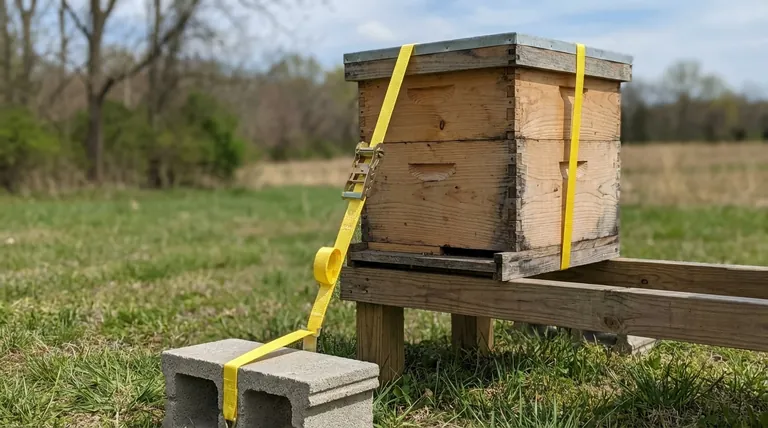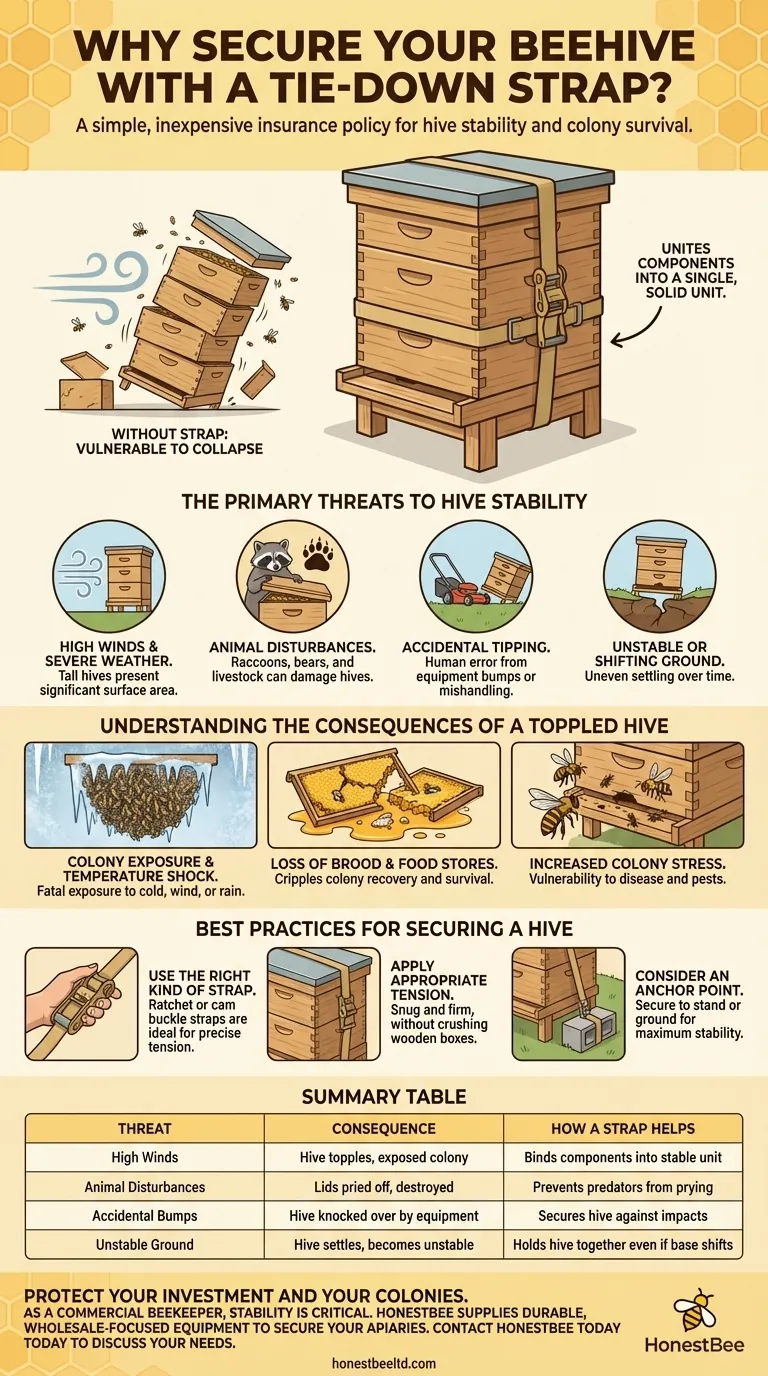At its core, a tie-down strap is a simple and inexpensive insurance policy for your beehive. It is used to bind the separate components of the hive—the bottom board, brood boxes, supers, inner cover, and outer cover—into a single, solid unit, preventing it from tipping over or being knocked apart. This simple action protects the hive from catastrophic damage and the colony from exposure to the elements during high winds or physical disturbances.
The fundamental purpose of a tie-down strap is to maintain the structural integrity of the hive against external forces. A compromised hive structure almost always leads to the rapid decline and death of the colony, making a strap one of the most effective, low-cost tools for ensuring its survival.

The Primary Threats to Hive Stability
While winter storms are a common catalyst for using a strap, the threats are present year-round. Understanding these risks clarifies why securing your hive is a fundamental aspect of responsible beekeeping.
High Winds and Severe Weather
This is the most obvious threat. A tall, stacked hive presents a significant surface area to the wind. Strong gusts can easily topple a hive that is not properly secured or weighted down.
Animal Disturbances
Many animals are attracted to the contents of a beehive. Raccoons are notorious for attempting to pry off lids to get to the honey and brood, while larger animals like bears can destroy an entire hive in minutes. Even livestock bumping against a hive can knock it over.
Accidental Tipping
Human error is a frequent cause of hive damage. A bump from a lawnmower, wheelbarrow, or other piece of equipment can be enough to topple an unsecured hive, causing immense damage and stress to the colony.
Unstable or Shifting Ground
Hives placed on soft ground can settle unevenly over time, especially after heavy rains. This can make the hive unstable and prone to tipping. A strap helps hold the components together even if the base is no longer perfectly level.
Understanding the Consequences of a Toppled Hive
A tipped or separated hive isn't just an inconvenience; it is an emergency for the colony. The outcome is often fatal if not discovered and corrected immediately.
Colony Exposure and Temperature Shock
The bees maintain a precise temperature and humidity level inside the hive, especially in the brood nest. When the hive is breached, this carefully controlled environment is destroyed. Exposure to cold, wind, or rain can kill the vulnerable brood and adult bees in a very short time.
Loss of Brood and Food Stores
When frames are broken and scattered, the colony loses its developing young (brood) and its vital food reserves of honey and pollen. This loss cripples the colony's ability to recover and survive.
Increased Colony Stress
A major disturbance puts the entire colony under extreme stress. The bees must expend enormous energy to repair damage, regulate temperature, and defend their exposed home, leaving them vulnerable to disease and pests.
Best Practices for Securing a Hive
Simply using a strap is not enough; using it correctly is what provides real security. The goal is to create a unified block without damaging the equipment.
Use the Right Kind of Strap
Ratchet straps or cam buckle straps are ideal. They are strong, weather-resistant, and allow you to apply precise tension. Avoid bungee cords, which do not provide consistent or sufficient force.
Apply Appropriate Tension
The strap should be snug and firm, but not so tight that it crushes the corners of the wooden boxes or warps the covers. The goal is to eliminate any shifting between the boxes, not to apply maximum force.
Consider an Anchor Point
For maximum security in areas with very high winds or large animal threats, the strap can be passed over the hive and secured to the hive stand itself or to cinder blocks placed on the ground. This prevents the entire hive from being tipped over.
Making the Right Choice for Your Apiary
The decision to use a strap should be based on a realistic assessment of your local conditions.
- If your primary focus is winter survival in a windy climate: A strap is an essential piece of winterizing equipment that prevents the hive from being breached during a storm.
- If your primary focus is protection from animals: A heavy-duty ratchet strap is a critical first line of defense against raccoons and other predators trying to pry the hive apart.
- If your primary focus is general peace of mind: Using a strap year-round provides constant protection against unexpected weather, accidental bumps, and other unforeseen events.
Ultimately, securing your hive is a proactive measure that safeguards the life of your colony and your investment as a beekeeper.
Summary Table:
| Threat | Consequence | How a Tie-Down Strap Helps |
|---|---|---|
| High Winds | Hive topples, exposing colony | Binds hive components into a single, stable unit |
| Animal Disturbances | Lids pried off, hive destroyed | Prevents predators from prying the hive apart |
| Accidental Bumps | Hive knocked over by equipment | Secures the hive against unexpected impacts |
| Unstable Ground | Hive settles and becomes unstable | Holds the hive together even if the base shifts |
Protect Your Investment and Your Colonies
As a commercial beekeeper or distributor, the stability of your hives is critical to your operation's success and profitability. A single toppled hive can mean the loss of a valuable colony and its honey production.
HONESTBEE supplies the durable, wholesale-focused beekeeping equipment you need to secure your apiaries effectively. From heavy-duty ratchet straps to the hive components they protect, we provide the reliable tools for commercial-scale success.
Ensure the safety of your bees and your business. Contact HONESTBEE today to discuss your wholesale supply needs and discover how our equipment can bring stability and peace of mind to your beekeeping operation.
Visual Guide

Related Products
- Professional Galvanized Hive Strap with Secure Locking Buckle for Beekeeping
- Versatile Ratchet Hive Strap with S-Hooks for Secure Fastening
- Heavy Duty Ratchet Hive Strap
- HONESTBEE Advanced Ergonomic Stainless Steel Hive Tool for Beekeeping
- Professional Drop-Style Hive Handles for Beekeeping
People Also Ask
- What are the two styles of hive straps? Choose the Right Strap for Your Hive Security
- How should a cam buckle strap be installed for optimal performance? Master the Leverage for Maximum Tension
- What are the types of Emlocks available? Choose the Right Strap for Hive Security
- What is the advantage of using cam buckle straps? Secure Your Load Fast with Simple, Safe Tensioning
- What is the best length for straps used around beehives? Why 12 Feet is the Industry Standard



















